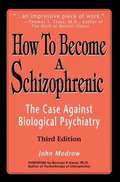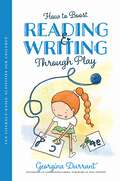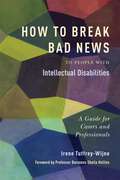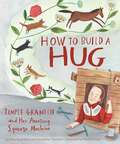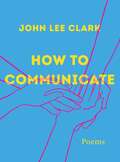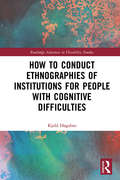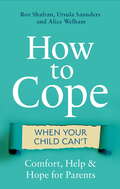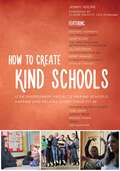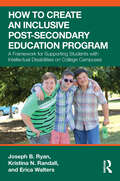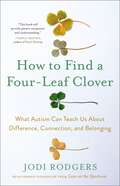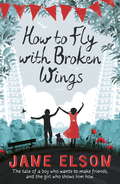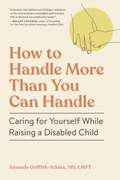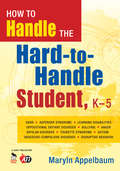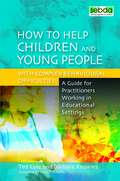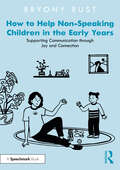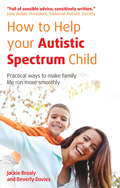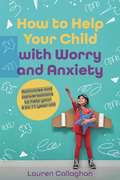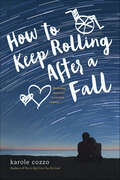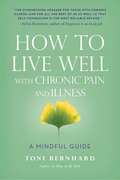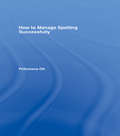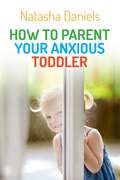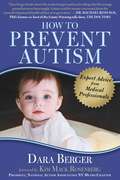- Table View
- List View
How to Become a Schizophrenic: The Case Against Biological Psychiatry
by John ModrowThe author describes his experience as a diagnosed schizophrenic and then examines the medical model of schizophrenia, which he believes to be seriously flawed.
How to Boost Reading and Writing Through Play: Fun Literacy-Based Activities for Children
by Georgina DurrantEven if children know their phonics and ABC's inside out and can read every book in their book bag, why is it still so difficult to get them to want to read and write? How do we begin to get our children excited about literacy? The answer might surprise you...let them play!Featuring 40 engaging play-based activities, this book makes literacy so fun that children won't notice they're also actively developing reading and writing skills. From blow painting words to making paper chain sentences, each activity can be done using household items and they are adaptable for children of any age and ability, making learning accessible for all. With charming black and white line illustrations to depict each activity, this is a great way to connect with children while helping to build their literacy skills at the same time.
How to Break Bad News to People with Intellectual Disabilities: A Guide for Carers and Professionals
by Irene Tuffrey-Wijne Sheila HollinsThis book offers unique and flexible guidelines that can be used by practitioners to ease the process of breaking bad news to people with intellectual disabilities. The guidelines, which are adaptable to individual communication ability and level of understanding, address the many complex needs of people with intellectual disabilities who can find understanding and accepting news that has a negative impact on their life a very difficult task. In the book, Irene Tuffrey-Wijne covers a range of different types of bad news, from bereavement and illness to more minor issues such as a change of accommodation, and offers highly practical and effective tips that will help carers and practitioners ensure that bad news is relayed as sensitively and successfully as possible. An easy-to-use and comprehensive guide, this book will be an invaluable resource of information for carers, health professionals such as doctors and nurses as well as families of people with intellectual disabilities.
How to Build a Hug: Temple Grandin And Her Amazing Squeeze Machine
by Amy GuglielmoAmy Guglielmo, Jacqueline Tourville, and Giselle Potter come together to tell the inspiring story of autism advocate Dr. Temple Grandin and her brilliant invention: the hug machine. <P><P> As a young girl, Temple Grandin loved folding paper kites, making obstacle courses, and building lean-tos. But she really didn’t like hugs. Temple wanted to be held—but to her, hugs felt like being stuffed inside the scratchiest sock in the world; like a tidal wave of dentist drills, sandpaper, and awful cologne, coming at her all at once. Would she ever get to enjoy the comfort of a hug? <P><P> Then one day, Temple had an idea. If she couldn’t receive a hug, she would make one…she would build a hug machine!
How to Communicate: Poems
by John Lee ClarkIn this collection of poems John Lee Clark writes from the inside about the experience of deafblindness. Poems share the richness and intimacy of tactile communication, the hilarity of errors in Sign as used by the hearing, and the complexity of relationships. Several poems explore the lives of historic blind and deafblind figures. Many of these poems were previously published in such literary journals as American Poetry Review, The Paris Review, and Poetry.
How to Conduct Ethnographies of Institutions for People with Cognitive Difficulties (Routledge Advances in Disability Studies)
by Kjeld HøgsbroThis book provides a comprehensive analysis of the methodological, theoretical, and meta-theoretical considerations and guidelines involved in undertaking institutional ethnographic work involving people with cognitive and communicative disabilities. It presents a coherent platform for integrating theory and method built on classical and recent anthropological and sociological theory as well as classic and recent methodological considerations within the ethnographic tradition. Furthermore, it introduces readers to the challenging work of understanding the lifeworld of people who cannot express themselves in ordinary ways or who are deeply stigmatised and oppressed by dominating discourses telling them how to understand and define their role in society. It will be of interest to all scholars, students and researchers of disability studies, particularly those who undertake ethnographic research or want to understand the challenges involved in doing so.
How to Cope When Your Child Can't: Comfort, Help and Hope for Parents
by Roz Shafran Ursula Saunders Alice WelhamParenting and caring for a child who is struggling to cope can be painful and stressful, and can make it very hard to enjoy life yourself. Feelings of blame, guilt, sorrow, despair, fear and frustration may be swirling around alongside a desperate desire to cure their pain.Although parenting a child who is experiencing difficulties is a common problem, we can feel desperately alone when it is happening to us. When someone we love is struggling - for whatever reason - we may become unhappy too. For countless parents and children there are problems with no easy solutions. However, that's where this book comes in. It aims to help understand for ourselves what we can and cannot do; to help us to accept any distress, worry, anxiety, sadness or loss of control in our situations; to see that we can tolerate these things; and to know that there are ways to move forward.This book is packed with stories from real parents, combined with information from psychological research. It will show you how you can manage to obtain comfort from knowing you are not alone, get help from resources and techniques that really work, and find hope that things can and do change for the better.
How to Cope When Your Child Can't: Comfort, Help and Hope for Parents
by Roz Shafran Ursula Saunders Alice WelhamParenting and caring for a child who is struggling to cope can be painful and stressful, and can make it very hard to enjoy life yourself. Feelings of blame, guilt, sorrow, despair, fear and frustration may be swirling around alongside a desperate desire to cure their pain.Although parenting a child who is experiencing difficulties is a common problem, we can feel desperately alone when it is happening to us. When someone we love is struggling - for whatever reason - we may become unhappy too. For countless parents and children there are problems with no easy solutions. However, that's where this book comes in. It aims to help understand for ourselves what we can and cannot do; to help us to accept any distress, worry, anxiety, sadness or loss of control in our situations; to see that we can tolerate these things; and to know that there are ways to move forward.This book is packed with stories from real parents, combined with information from psychological research. It will show you how you can manage to obtain comfort from knowing you are not alone, get help from resources and techniques that really work, and find hope that things can and do change for the better.
How to Create Kind Schools: 12 extraordinary projects making schools happier and helping every child fit in
by Henry Winkler Anthony Horowitz Friends Michael Sheen Jamie Oliver Families The Prince's Trust Jack Jacobs Charlie Condou Diversity Role Models Nocturn Dance Achievement For All Youth Dance England Baroness Janet Whitaker Jenny Hulme Linda Jasper David Martin Domoney Jane Asher 2faced Dance Beat Kidscape Claude Knights The National Autistic Society Ade Adepitan Kidscape Dance United Carers Trust Nspcc David Charles Manners Thrive Jill Halfpenny The Mentoring Befriending Foundation TravellersCelebrating the 30th Anniversary of Kidscape, the national charity that works to challenge and prevent bullying, this book offers readers an insight into a collection of innovative projects currently running in schools to promote inclusion, tolerance and kindness.<P><P> From a gay role model to a peer mentor, a dance workshop to a gardening club, an autism ambassador to a travelling Gypsy theatre group, the ideas demonstrate how much we have to teach our children about inclusion, how much kindness matters, and how much of a difference schools can make to children who don't always feel they fit. Joining forces with well-known charities and celebrity supporters including Anthony Horowitz, Jamie Oliver, Michael Sheen and more, these accessible, fun and effective projects are tackling issues such as bullying, homophobia, racism, and truancy, are supporting pupils who may feel isolated and excluded from their peer group, and are helping whole schools become happier, more successful settings.<P> This book will provide inspiration to all educational professionals, parents and volunteers looking for creative and practical ways to help individual children fit in and feel happy in their class.
How to Create an Inclusive Post-Secondary Education Program: A Framework for Supporting Students with Intellectual Disabilities on College Campuses
by Joseph B. Ryan Kristina N. Randall Erica WaltersThis essential guide offers a practical framework for developing a successful Post-Secondary Education (PSE) program for students with intellectual disabilities—one of the fastest-growing areas in higher education. Written by leaders of one of the nation's top PSE programs, this book distills their extensive experience mentoring over 90 colleges and universities into a practical, jargon-free guide. Featuring clear, actionable insights for creating a successful, tailor-made program, chapter topics include functional academics, independent living skills, and employment readiness. Written for college administrators, special education teachers, and parents, this book sheds light on how PSE programs not only enrich the college experience for students with intellectual disabilities but also equip them with the skills to thrive as self-sufficient adults.
How to Find a Four-Leaf Clover: What Autism Can Teach Us About Difference, Connection, and Belonging
by Jodi RodgersA powerfully moving read from beloved Love on the Spectrum star and disability rights advocate Jodi Rodgers, sharing lessons from her work within the autistic community that can help create a more inclusive society for us all. In How to Find a Four-Leaf Clover, Jodi Rodgers gives us inspiring, heartwarming stories from her years of experience as a teacher and counselor supporting autistic people. While acknowledging our differences, these stories invite us to expand our empathy and compassion for the neurodivergent people in our lives. Throughout, Rodgers explores the powerful impact of embracing neurodiversity and forming meaningful connections with those around us. Each chapter highlights a different story and an aspect of human behavior, including: How we perceive the world, and our own unique experience of thinking, sensing, and feeling How we communicate our perspective to others, understand one another, and express ourselves How we can better connect with one another With dozens of moving stories, How to Find a Four-Leaf Clover will give readers a deeper understanding of and appreciation for the neurodiverse community around them. Above all, it will inspire a profound sense of belonging, revealing that we&’re much more similar than we think.
How to Fly with Broken Wings
by Jane Elson'If Finn Maison shouts jump you jump or you are dead.'Twelve-year-old Willem has two main aims in life: to fly and to make at least two friends of his own age. But all the other boys from the Beckham Estate do is make him jump off things. First his desk - and now the wall. As his toes teeter on the edge, Sasha Bradley gives him a tiny little wink. Might she become his friend?Bullied by Finn and his gang the Beckham Estate Boyz, Willem has no choice but to jump. As he flies through the air he flaps his arms, wishing he could fly and escape into the clouds. Instead he comes crashing down and breaks his ankle.Sasha, angry with herself for not stopping Finn and his Boyz, is determined to put things right. And soon, while the gangs riot on their estate, Willem and Sasha form an unlikely friendship. Because they share a secret. Sasha longs to fly too.And when Magic Man Archie arrives with stories of war-flying spitfires, he will change the lives of the kids on the Beckham Estate for ever. And perhaps find a way for Willem and Sasha to fly ...Touching on themes such as friendship and bullying, this is a charming tale about overcoming obstacles and finding friendship in unlikely places.'heart-rending, heartbreaking and heartening' The Best New Children's Books Guardian Supplement
How to Fly with Broken Wings
by Jane Elson'If Finn Maison shouts jump you jump or you are dead.'Twelve-year-old Willem has Aspergers Syndrome and two main aims in life: to fly and to make at least two friends of his own age. But all the other boys from the Beckham Estate do is make him jump off things. First his desk - and now the wall. As his toes teeter on the edge, Sasha Bradley gives him a tiny little wink. Might she become his friend?Bullied by Finn and his gang the Beckham Estate Boyz, Willem has no choice but to jump. As he flies through the air he flaps his arms, wishing he could fly and escape into the clouds. Instead he comes crashing down and breaks his ankle.Sasha, angry with herself for not stopping Finn and his Boyz, is determined to put things right. And soon, while the gangs riot on their estate, Willem and Sasha form an unlikely friendship. Because they share a secret. Sasha longs to fly too.And when Magic Man Archie arrives with stories of war-flying spitfires, he will change the lives of the kids on the Beckham Estate for ever. And perhaps find a way for Willem and Sasha to fly ...Touching on themes such as friendship and bullying, this is a charming tale about overcoming obstacles and finding friendship in unlikely places.'heart-rending, heartbreaking and heartening' The Best New Children's Books Guardian Supplement
How to Handle More Than You Can Handle: Caring for Yourself While Raising a Disabled Child
by Amanda Griffith-AtkinsA guide to navigating the emotional experience of caring for and raising disabled children with high-support needs, from a therapist and parent of a disabled child. Amanda Griffith-Atkins, a therapist who is also one of the millions of people raising a disabled child with high-support needs, knows firsthand about the dark places parents go—the grief, the anger, the frustration—and the shame these feelings can bring up. In her practice, and now her book, she gives parents an invaluable set of tools to find the strength, acceptance, and self-compassion to face these hard emotions to become a more forgiving and healthier version of themselves---and better caretakers for their children. She takes readers through the different emotions of this unique parenting journey: the shock of diagnosis, the fight for resources, the anxiety of navigating your child&’s growing independence, the uncertainty of how best to prepare for their future without you. Then she turns her lens to the parent&’s world and how to navigate the fraught territory of marriage, identity, expectations, guilt, managing non-disabled siblings, and more. She shows us that bringing your darkest feelings into the light and showing up as your full self is the best way to get out of survival mode. Because you—and your child—deserve it.
How to Handle the Hard-to-Handle Student, K-5
by Maryln S. AppelbaumThe author helps teachers promote students' ability to handle emotions, regulate their own behavior, and learn in ways that meet their needs and those of the class.
How to Help Children and Young People with Complex Behavioural Difficulties
by Ted Cole Barbara Knowlesxx
How to Help Non-Speaking Children in the Early Years: Supporting Communication through Joy and Connection
by Bryony RustIn every setting there are children who struggle to communicate. When they’re not talking, or only using a handful of words, it can be hard to know how to help. In this book, you’ll be encouraged to spot early moments of communication and respond with clarity. You’ll find an invitation to stop doing and start noticing, to try new things and collaborate with the team around you.The book presents key concepts in bite-size chunks, with a wealth of real-life examples from speech therapy sessions and early years settings. It explores practical strategies to help children develop their foundational speech, language and communication skills, and includes fresh ideas to:· Build honest and supportive conversations with parents about communication needs· Value empathy and imagination as we tune in to each child’s world· Take a pro-neurodiversity lens to inform your practice· Measure progress and support professional development.Communication is core to our sense of wellbeing, personal agency and belonging. With a focus on fostering joyful moments of connection, this book offers a fresh perspective and a dose of encouragement for all early years practitioners, speech and language therapists, SENCOs and key people looking to support positive communication development in the children in their care.
How to Help Your Autistic Spectrum Child: Practical ways to make family life run more smoothly
by Jackie Brealy Beverly DaviesOver half a million people in Britain are somewhere on the autistic spectrum. It can be devastating to discover that your child has an ASD (autistic spectrum disorder) and even tougher helping them to cope with life. Many books will tell you the latest theories about what causes ASD, but what you really want to know is how to get a decent night's sleep, or stop your child flapping their arms, or find some time for your other children. This second, fully updated edition of this lifeline for parents helps them understand their ASD child and offers practical advice on all the problems that can make day-to-day life so tough.
How to Help Your Autistic Spectrum Child: Practical ways to make family life run more smoothly
by Jackie Brealy Beverly DaviesOver half a million people in Britain are somewhere on the autistic spectrum. It can be devastating to discover that your child has an ASD (autistic spectrum disorder) and even tougher helping them to cope with life. Many books will tell you the latest theories about what causes ASD, but what you really want to know is how to get a decent night's sleep, or stop your child flapping their arms, or find some time for your other children.This second, fully updated edition of this lifeline for parents helps them understand their ASD child and offers practical advice on all the problems that can make day-to-day life so tough.
How to Help Your Child with Worry and Anxiety: Activities and Conversations for Parents to Help Their 4-11-Year-Old
by Lauren CallaghanAs a parent, it’s heart-breaking watching your child struggle with anxious thoughts, or seem constantly worried about something. Anxiety is sadly common in children, and can affect their sleep, mood and general wellbeing.How to Help your Child with Worry and Anxiety is a must-read handbook for parents of children aged 4-11 years old who experience anxiety. Clinical psychologist Dr Lauren Callaghan provides you with concise and accessible information, explaining how anxiety works in children, and what you can do to help. You will be shown how to help your child overcome this spiral of anxious thoughts and learn to manage their thoughts and feelings.Dr Callaghan explains clinically proven strategies to help your child to recognise and process anxious thoughts, including scripts to steer a conversation, and activities designed to help your child explore their worries and give them the emotional skills to feel less anxious.
How to Keep Rolling After a Fall
by Karole CozzoThe party was at her house. The photos were posted to her Facebook account. That's all the evidence anyone needed to condemn Nikki Baylor for a cyberbullying incident that humiliated a classmate and nearly resulted in the girl's suicide. Now Nikki's been expelled from her old school, her friends have abandoned her, and even her own parents can't look her in the eye. With her plans for the future all but destroyed, Nikki resigns herself to being the girl everyone hates - almost as much as she hates herself. But then Nikki meets Pax, a spirited wheelchair rugby player who knows what it's like when one mistake completely shatters your life. Refusing to judge her because of her past, he shows her that everyone deserves a second chance... and everyone deserves to be loved.
How to Live Well with Chronic Pain and Illness
by Toni BernhardComfort, understanding, and advice for those who are suffering--and those who care for them.Chronic illness creates many challenges, from career crises and relationship issues to struggles with self-blame, personal identity, and isolation. Beloved author Toni Bernhard addresses these challenges and many more, using practical examples to illustrate how mindfulness, equanimity, and compassion can help readers make peace with a life turned upside down. In her characteristic conversational style, Bernhard shows how to cope and make the most of life despite the challenges of chronic illness. Benefit from: * Mindfulness exercises to mitigate physical and emotional pain * Concrete advice for negotiating the everyday hurdles of medical appointments, household chores, and social obligations * Tools for navigating the strains illness can place on relationships Several chapters are directed toward family and friends of the chronically ill, helping them to understand what their loved one is going through and how they can help. Humorous and empathetic, Bernhard shares her own struggles and setbacks with unflinching honesty, offering invaluable support in the search to find peace and well-being.
How to Manage Spelling Successfully
by Philomena OttReaders will find this practical and comprehensive guide to spelling invaluable. Day-to-day advice on how to help those with difficulties is underpinned by information on the development of the English language and its spelling rules with explanations of common language problems. Chapters cover: spelling processes teaching and learning phonics individual cognitive and learning styles assessing and monitoring spelling progress teaching strategies and techniques. This is an essential companion for teachers, SENCos, and dyslexia specialists alike, as well as anyone interested in spelling and language difficulties.
How to Parent Your Anxious Toddler
by Natasha DanielsWhy does your toddler get upset when his or her routine is disrupted? Why do they follow you from room to room and refuse to play on their own? Why are daily routines such as mealtimes, bath time, and bed time such a struggle? This accessible guide demystifies the difficult behaviors of anxious toddlers, offering tried-and-tested practical solutions to common parenting dilemmas. Each chapter begins with a real life example, clearly illustrating the behavior from the parent's and the toddler's perspective. Once the toddler's anxious behavior has been demystified and explained, new and effective parenting approaches are introduced to help parents tackle everyday difficulties and build up their child's resilience, independence, and coping mechanisms. Common difficulties with bath time, toileting, sleep, eating, transitions, social anxiety, separation anxiety, and sensory issues are solved, along with specific fears and phobias, and more extreme behaviors such as skin picking and hair pulling. A must-read for all parents of anxious toddlers, as well as for the professionals involved in supporting them.
How to Prevent Autism: Expert Advice from Medical Professionals
by Scott Smith Katie Wright James Lyons-Weiler Kim Mack Rosenberg Dara Berger Dr Sidney Baker Dr Nancy O'Hara Geri Brewster Maureen McDonnel Dr Anju Usman Dr Stephanie Seneff Maria Rickert-Hong Corinne Simpson BrownThe statistics are alarming and become more so every year. The Centers for Disease Control and Prevention estimates that 1 in 68 children have been identified with an autism spectrum disorder, making it one of the fastest growing developmental disorders in the United States. Further, the CDC estimates that parents with a child on the autism spectrum can have nearly a 20 percent chance of having a second child with autism.In How to Prevent Autism, Dara Berger shares her personal journey with autism. She describes everything that went wrong with her son that led to an autism diagnosis and everything she did differently to prevent her daughter from suffering the same fate. She interviews eight well-known ASD experts--including doctors, nutritionists, nurses, and scientists--about the factors that have led to the growing epidemic of autism. Based on the best practices for preventing autism in children, each professional offers perspectives grounded in their own research and their patients’ improvements. The book covers every detail--from the importance of mothers’ cleaning out their bodies preconception, through common genetic mutations that may put children at risk, to the crucial role of nutrition in prevention.All parents agree that every choice counts when it comes to the health of their children. As Dara Berger makes clear in this personal, informative, and authoritative book, the stakes could not be higher when it comes to autism.
